TKC Internet Service Center(TISC)
The site of cloud-based services that offer safety, security, and convenience
TKC operates the TKC Internet Service Center (TISC) to provide cloud-based services to its customers, including accounting firms and their clients, local governments, as well as medium- and large-sized companies. TISC ensures that the services are utilized in a safe and secure ICT environment so that customers can maintain and continue their operations even under unforeseen circumstances.
To provide stable cloud-based services, the Data Center boasts to be equipped with private power generators (that can operate for 72 hours) and many other pieces of equipment and to be housed within a robust structure strong enough to withstand disasters, where a cloud service infrastructure utilizing the latest IT equipment has been built. Every effort has also been made to ensure stable operation by having TKC’s full-time employees monitor the operational status of the services around the clock. In addition, we strive to protect the data entrusted to us by our customers through the continuous strengthening of measures against cyber attacks, acquisition of certifications related to international information security standards, and the rigorous training of employees.
TKC will continue to provide safe, secure, and convenient cloud-based services from this Data Center to support the business operations of customers.
Certifications
●ISO/IEC 27001: Information security management system certification
●ISO/IEC 27017: ISMS cloud security certification
●ISO/IEC 20000: IT service management system certification
●Authorized Local Government Wide Area Network ASP (LGWAN-ASP) service provider
TISC has been authorized as a service provider that utilizes LGWAN operated by the Japan Agency for Local Authority Information Systems (J-LIS).
- Facility services (passed on October 20, 2003)
- Hosting services (passed on November 28, 2003)
- Application and content services (passed on November 28, 2003)
●Authorized service provider of the Local Tax Agency
ISAE 3402 Audit: Assessment of internal controls over services entrusted
TKC has received the Assurance Report on Controls at a Service Organization (ISAE 3402 audit report) based on the Auditing and Assurance Practice Committee Practical Guidelines No. 3402 issued by the Japanese Institute of Certified Public Accountants for internal controls related to the following services offered at TISC:
- Electronic Tax Filing System for Corporations (ASP1000R)
- Consolidated Tax Payment System (eConsoliTax)
- Group Tax Sharing System (e-TAX Group Sharing)
- Consolidated Accounting System (eCA-DRIVER)
- Tax Effect Accounting System (eTaxEffect)
- Integrated Accounting Information System (FX5)
- Integrated Accounting Information System (FX4 Cloud)
- Electronic Tax Filing System (e-Tax Consumption Tax)
- Fixed Assets Management System (FAManager)
Overview of TISC
| 1. Server room floor area: | 3,412m2 (approximately 1,034-tsubo) |
|---|---|
| 2. Countermeasures against earthquakes: | Seismic isolation (continued use possible even in the event of an earthquake measured up to 7 on the Japanese intensity scale) |
| 3. Floor load: | 816kg/m2 |
| 4. Power receiving system: | 6.6kV high-voltage double-circuit power receiving system |
| 5. Redundancy in electrical equipment: | Redundant up to power distribution boards (redundancy inside racks optional); no blackout during electrical equipment inspections |
| 6. Emergency back-up power generator: | Gas turbine generator |
| 7. Fuel stockpile for generator: | Stockpile of fuel to run 72 hours |
| 8. UPS | 10 minutes or longer |
| 9. Grounding system: | Adopts IEC-compliant surge protective devices (SPD) and equipotential bonding grounding system |
| 10. HVAC: | Air cooled packaged air conditioners |
| 11. Temperature and humidity controls: | 24ºC±2ºC, 50% ±10% |
| 12. Fire detection system: | Ultra-sensitive smoke detection sensors |
| 13. Fire-fighting system: | NN100 (inert gas extinguisher consisting of nitrogen gas; no ozone-depleting potential, no global warming potential) |
| 14. Systems operation and monitoring: | 24-hour, 365-day manned monitoring |
| 15. Access control: | Door access control by IC cards throughout the building (access to server room controlled by biometric authentication) |
| 16. Surveillance cameras: | Installed along building perimeter and inside the building |
| 17. Communication lines: | Multi-carrier compatible |
| 18. Zinc whisker prevention: | Completely whisker-free server room |
| 19. Environmental considerations: | Use of outside air, hot aisle chamber system, etc. |
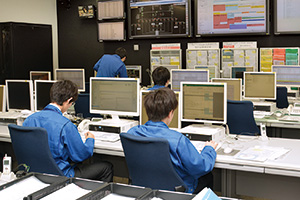 1
1
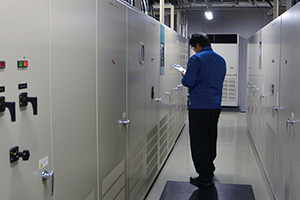 2
2
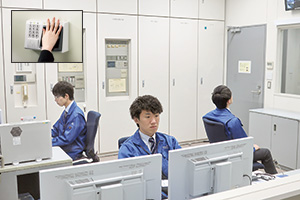 3
3
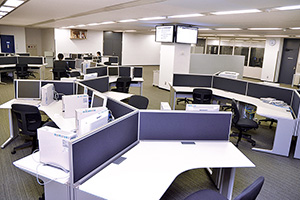 4
4
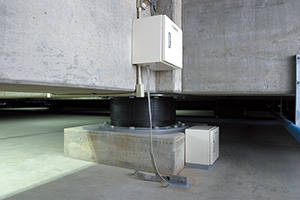 5
5
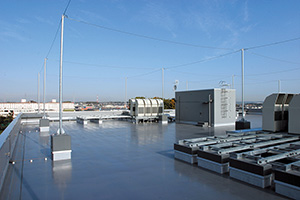 6
6
- Systems monitoring
Full-time employees perform manned monitoring around the clock. - Patrol monitoring
Employees patrol the entire building on a regular basis and check the situation in the building as well as the operational status of each and every machine. - Security
All doors throughout the building require an IC card to open. In particular, access to the server room is controlled by a palm vein authentication system, a type of biometric authentication. The conditions inside and outside the Center are monitored centrally at the disaster prevention center. - Dedicated cloud technicians
Dedicated cloud technicians design and build the cloud service infrastructure based on the latest virtualization technologies and support the stable operation of cloud-based services at all times. - Countermeasures against earthquakes
Twenty-four seismic isolators made of alternating layers of hard rubber and steel plates support the TISC building. These isolators can absorb seismic energy of an earthquake measured up to 7 on the Japanese intensity scale and prevent servers in the building from falling over and being damaged. - Lightning protection
In addition to the external lightning protection (building protection) required under JIS, the building is equipped with protection measures that support the internal lightning protection system prescribed by the International Electrotechnical Commission (IEC) so that electronic equipment installed in the building will not be affected by lightning.